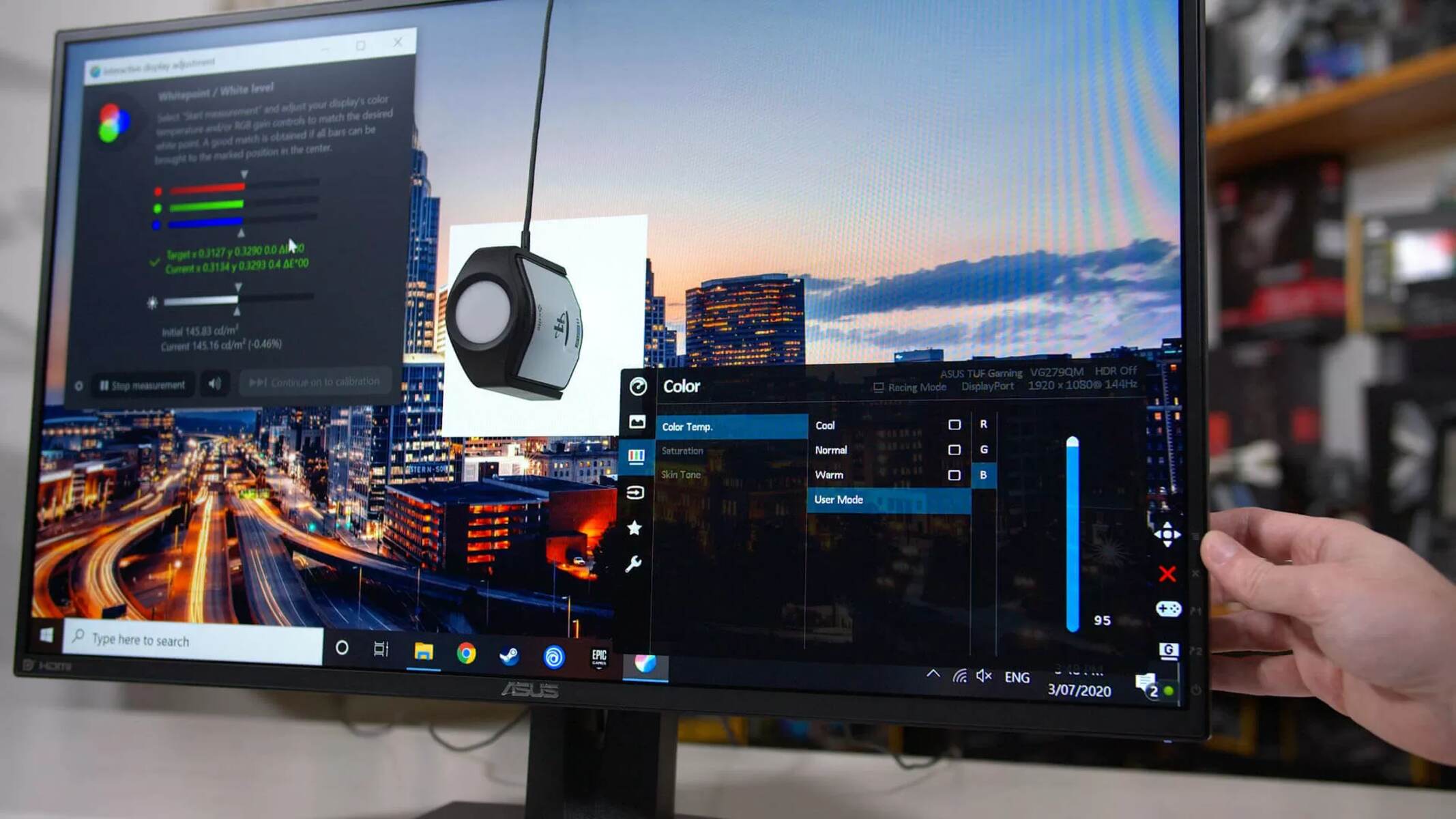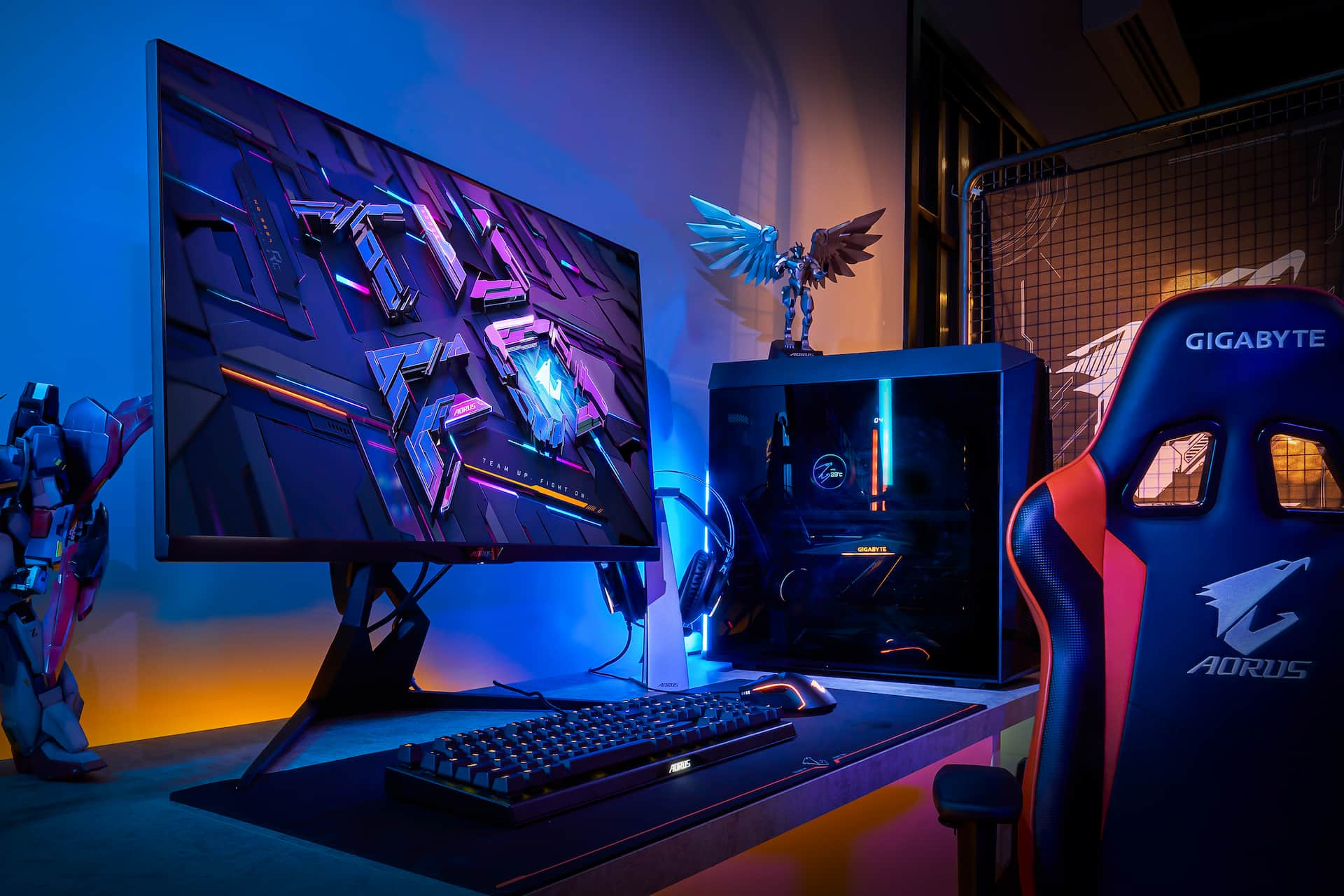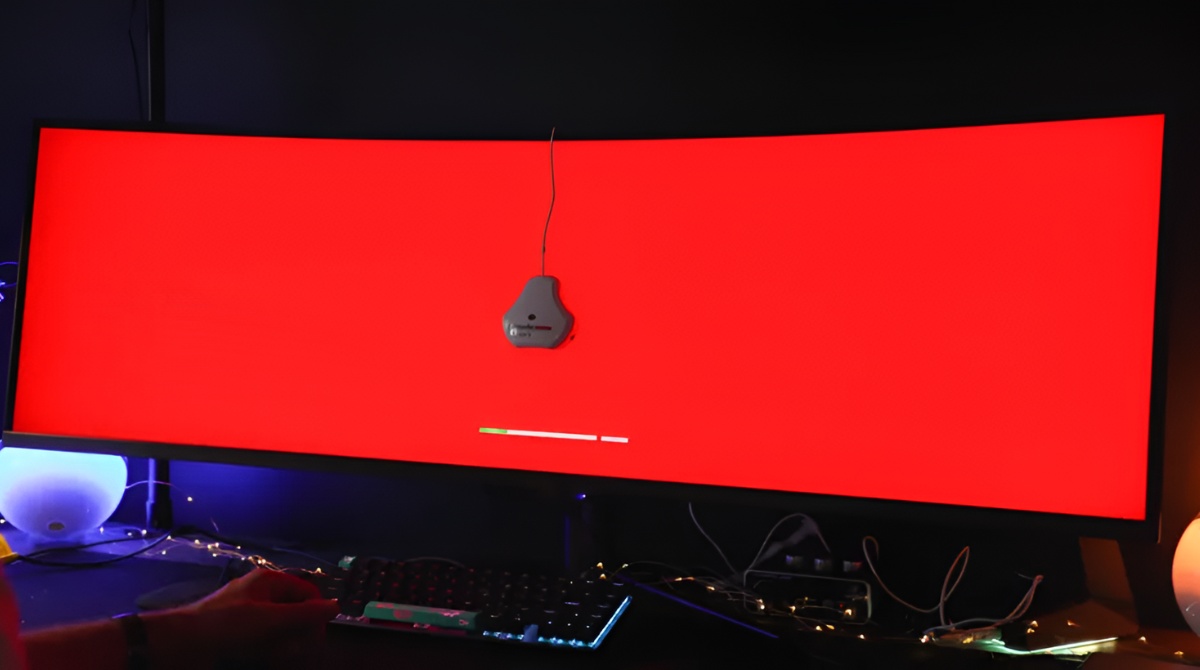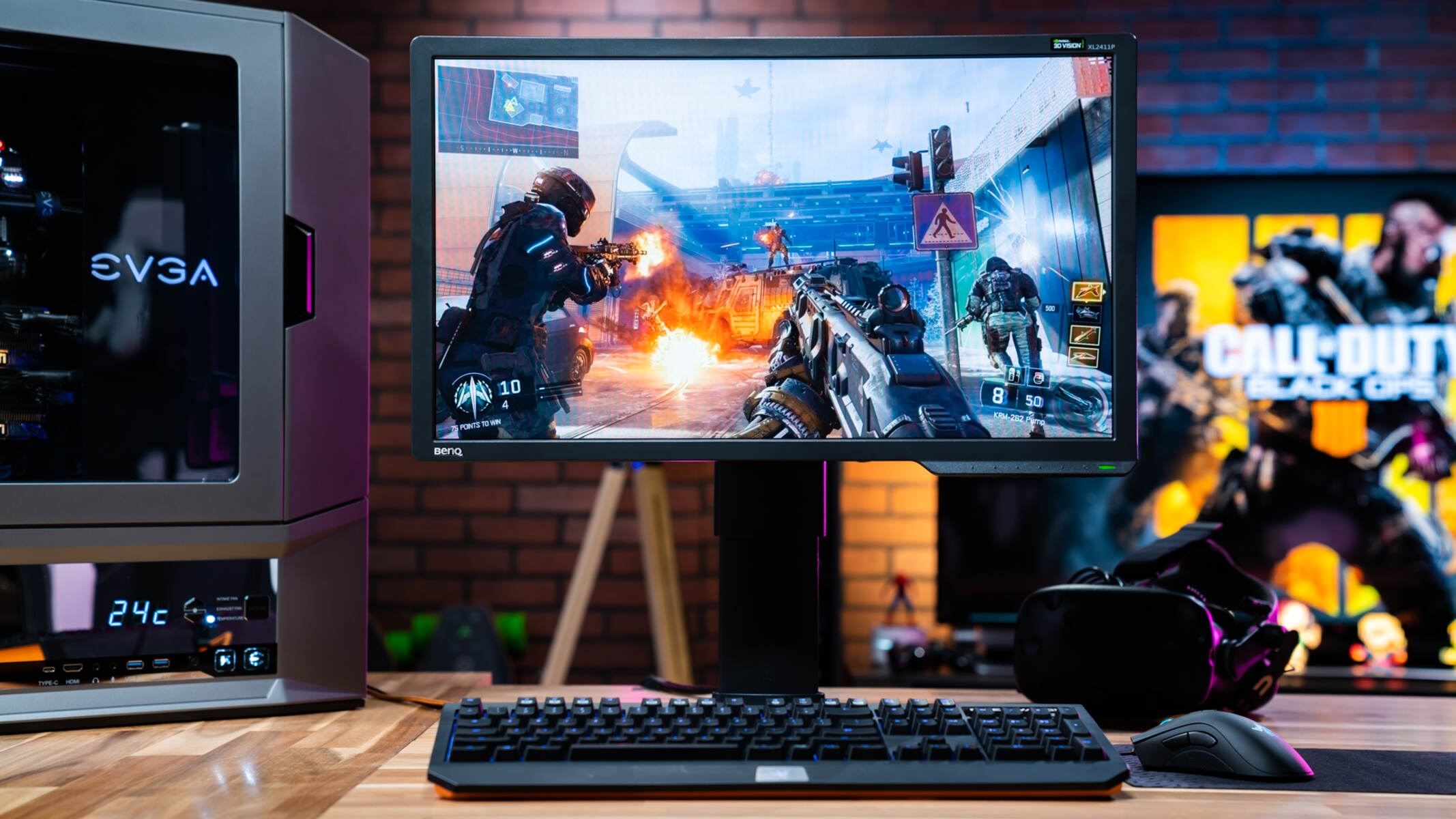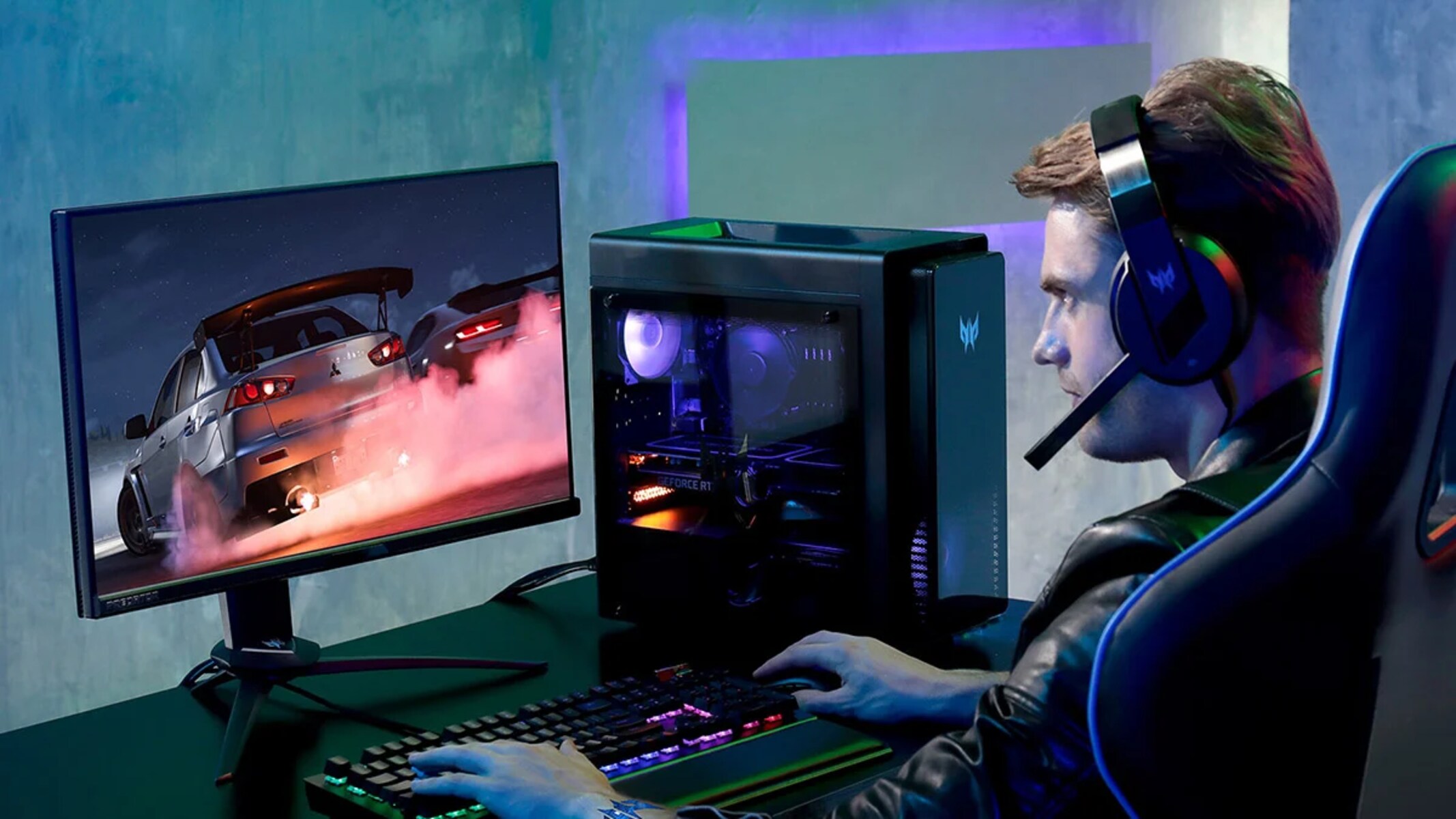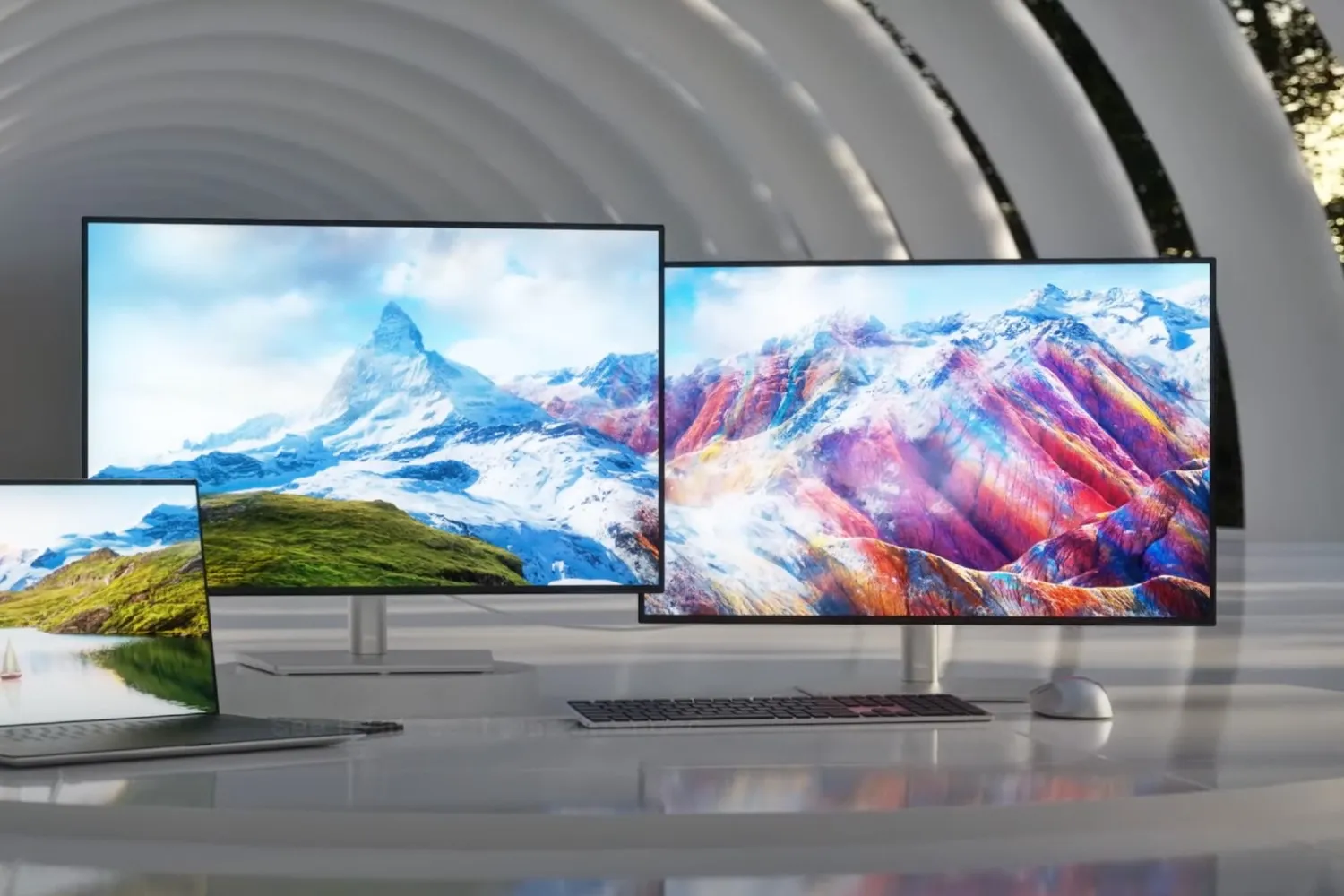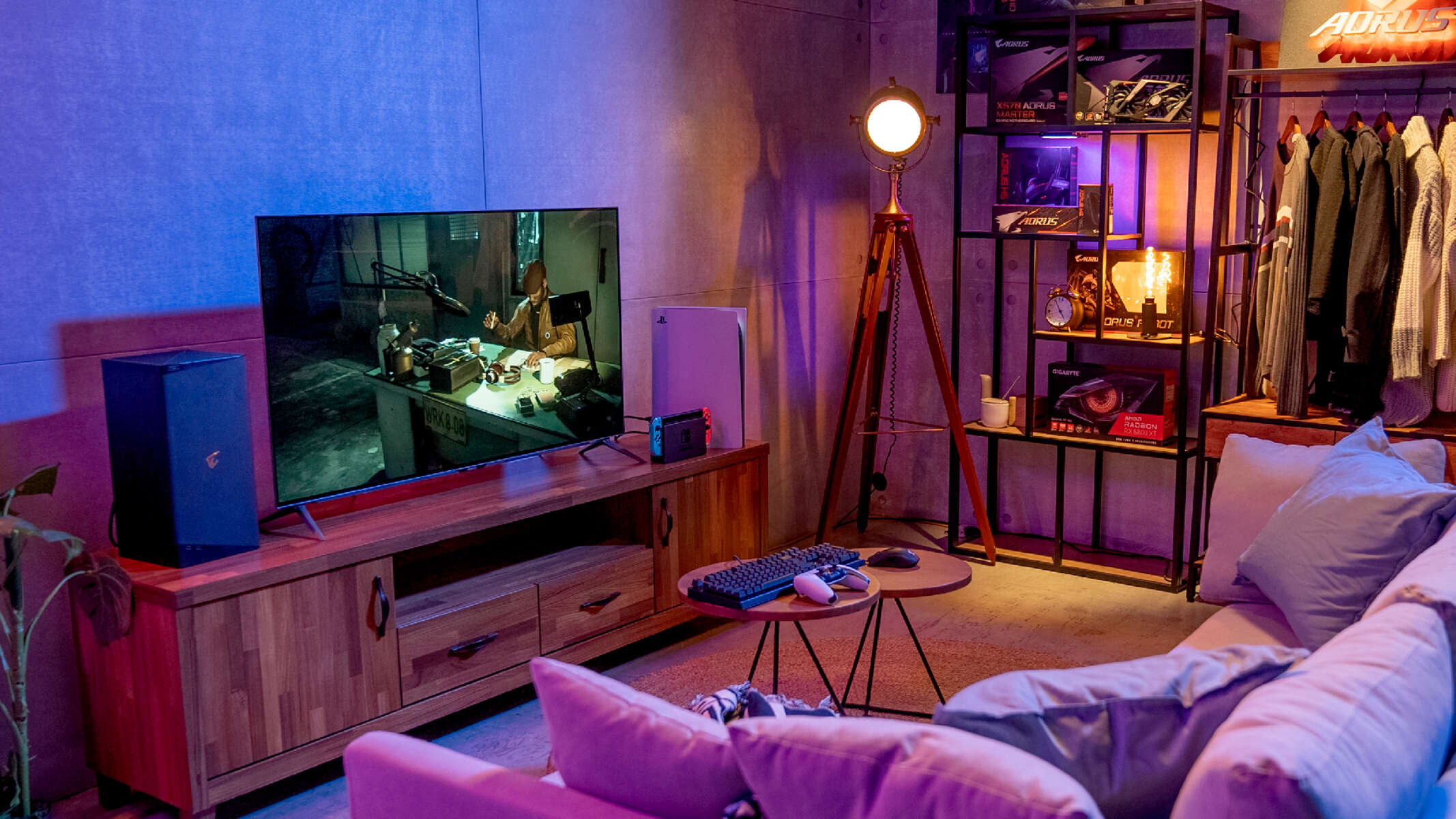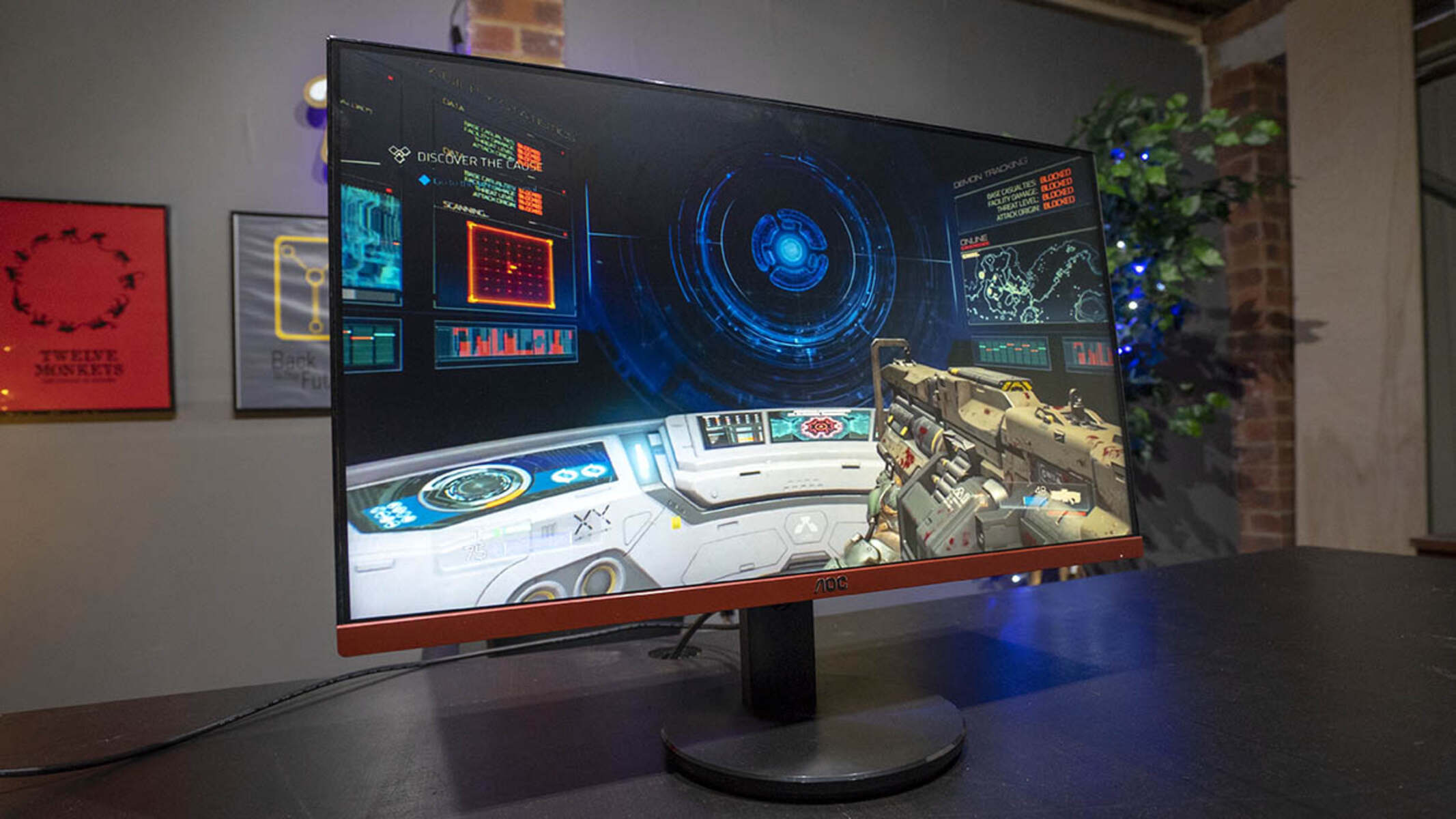Introduction
Having a properly calibrated gaming monitor is essential for an immersive and enjoyable gaming experience. Whether you’re a casual gamer or a professional competitor, ensuring that your monitor is displaying accurate colors and optimal settings can greatly enhance your gameplay. In this guide, we will walk you through the process of calibrating your gaming monitor to achieve the best visuals.
Monitor calibration refers to adjusting various settings on your display to achieve accurate colors, contrast, and brightness levels. Out of the box, monitors are often set to default settings that may not provide the most accurate or pleasing visuals. By calibrating your monitor, you can ensure that games look vibrant and true to life, allowing you to fully immerse yourself in the virtual world.
Before diving into the calibration process, it’s important to understand the various aspects of monitor calibration and their impact on your gaming experience. Contrast and brightness control the difference between light and dark areas, while color temperature determines the overall warmth or coolness of the display. Gamma affects the brightness levels at different shades, while saturation and hue control the intensity and tone of colors. Additionally, color balance ensures that colors are evenly distributed across the spectrum, reducing any color biases.
Choosing the right calibration tool is crucial for accurate results. While some monitors come with built-in calibration tools, they may not be as precise as dedicated external devices. These devices, such as colorimeters or spectrophotometers, provide more accurate measurements and allow for a more precise calibration process. Investing in a calibration tool can be beneficial in the long run, as it ensures consistent and accurate results across different lighting conditions and games.
In the following sections, we will guide you through the step-by-step process of calibrating your gaming monitor. From adjusting contrast and brightness to fine-tuning color temperature and gamma, we will cover all the essential settings to optimize your gaming visuals. Additionally, we will discuss how to address color balance issues and check for uniformity problems that may impact your gaming experience.
It’s important to note that calibrating your monitor may vary depending on the specific model and brand. It’s always recommended to consult the user manual or online resources specific to your monitor for detailed instructions. With that said, let’s dive into the world of monitor calibration and enhance your gaming visuals!
Understanding Monitor Calibration
Before delving into the process of calibrating your gaming monitor, it’s important to understand the underlying principles and factors that affect the display of colors and visuals. Monitor calibration refers to the adjustment of various settings to ensure accurate and consistent colors, contrast, brightness, and overall image quality.
One of the essential elements in monitor calibration is contrast, which dictates the difference between bright and dark areas on the screen. When contrast levels are too high, dark areas may appear washed out, while low contrast can result in a lack of depth and detail in brighter regions. Calibrating the contrast settings allows you to find the optimal balance, revealing the details in both highlights and shadows.
Brightness is another crucial aspect of monitor calibration. If the brightness is too low, the image may appear dull and lack detail. Conversely, excessive brightness can cause eye strain and make colors look washed out. Adjusting the brightness ensures a comfortable and visually appealing experience without sacrificing details or causing eye fatigue.
Color temperature is a vital component of monitor calibration. It refers to the overall warmth or coolness of the display. The standard color temperature for most monitors is around 6500 Kelvin, which provides a neutral white point. However, depending on your personal preference and lighting conditions, you may prefer a slightly warmer or cooler temperature. Achieving the right color temperature enhances the accuracy and realism of colors displayed on your monitor.
The gamma setting controls how your monitor displays different shades of brightness. This adjustment ensures that the transition from dark to light is smooth and consistent. A gamma setting that is too high will result in crushed shadows and loss of detail, while a low gamma can make the image appear washed out. Aim to find the ideal gamma level that preserves details while providing a visually pleasing experience.
Saturation and hue are responsible for the intensity and tone of colors. Adjusting these settings allows you to achieve vibrant and accurate colors that bring your games to life. Be mindful not to oversaturate colors, as it may lead to an unnatural appearance. Finding the right balance ensures that colors are visually appealing without compromising accuracy.
Color balance is another critical aspect of monitor calibration. It involves ensuring that colors are evenly distributed across the entire color spectrum, reducing any bias towards certain tones. An imbalance in color distribution can result in inaccurate and unrealistic visuals. By calibrating color balance, you can achieve more accurate and natural-looking colors in your games.
Understanding the various elements of monitor calibration is crucial to optimize your gaming experience. With a properly calibrated monitor, you can enjoy games with accurate colors, optimal brightness and contrast, and enhanced visual fidelity. In the next sections, we will explore the step-by-step process of calibrating your gaming monitor to elevate your gameplay.
Choosing the Right Calibration Tool
When it comes to calibrating your gaming monitor, having the right calibration tool is essential for achieving accurate and consistent results. While some monitors come with built-in calibration options, dedicated external calibration devices often offer more precise and comprehensive calibration capabilities.
External calibration tools, such as colorimeters and spectrophotometers, are specifically designed to measure and adjust color accuracy and other visual settings. These devices provide more accurate readings and allow for a more precise calibration process compared to the built-in options found in some monitors.
Colorimeters are a popular choice among gamers and professionals alike. They consist of a small sensor that is placed against the monitor screen. The colorimeter measures the color and brightness values displayed by the monitor and provides recommendations for adjustments. Some advanced colorimeters can even create an ICC profile, which is a calibration file that helps ensure consistent color accuracy across different applications and monitors.
Spectrophotometers, although more expensive, offer even higher accuracy and precision than colorimeters. These devices use a prism or diffraction grating to break down light into its individual wavelength components, allowing for extremely precise measurements of color and luminance. Spectrophotometers are often used in professional photography and graphic design industries where absolute color accuracy is crucial.
Before purchasing a calibration tool, it’s important to consider the specific needs of your gaming setup and budget. If you’re a casual gamer or simply looking to improve the visual quality of your games, a colorimeter should suffice. However, if you’re a professional gamer or involved in color-critical work, investing in a spectrophotometer may be worth considering.
Additionally, it’s important to ensure that the calibration tool is compatible with your computer and operating system. Most calibration devices come with software that allows you to perform the calibration process and make adjustments to your monitor’s settings. Make sure that the software is compatible with your preferred platform and has the necessary features to meet your calibration needs.
While external calibration tools provide more accurate results, it’s worth noting that they require a level of expertise and time investment to achieve optimal calibration. It’s recommended to follow the instructions provided by the manufacturer and consult calibration guides tailored to your specific monitor model.
By choosing the right calibration tool for your needs and following the proper calibration procedures, you can ensure accurate and consistent color reproduction on your gaming monitor. The next sections will guide you through the step-by-step process of adjusting contrast, brightness, color temperature, and other settings to further enhance the visual quality of your gaming experience.
Adjusting Contrast and Brightness
When calibrating your gaming monitor, one of the first settings you’ll want to adjust is contrast and brightness. These two settings play a crucial role in defining the clarity and visibility of the displayed image.
Contrast controls the difference between the darkest blacks and the brightest whites of your monitor. It is responsible for the overall depth and detail in the image. Adjusting contrast is essential to ensure that dark areas are sufficiently dark and bright areas are not washed out. A monitor with low contrast may result in a loss of details in darker areas, while excessive contrast can lead to an image that appears over-saturated and unrealistic.
To adjust contrast, follow these steps:
- Access the monitor’s settings menu. The method can vary depending on the monitor model, but it usually involves pressing the menu button located on the front or side of the monitor.
- Navigate to the contrast adjustment option. It is typically found under the display or picture settings menu.
- Adjust the contrast level gradually. Increase the contrast to enhance the difference between dark and light areas, or decrease it if the image looks too harsh or unnatural. Aim for a balance that preserves details while providing a visually pleasing image.
- Confirm the changes and exit the menu. Your monitor should now reflect the adjusted contrast settings.
Next, let’s move on to adjusting the brightness of your monitor. Brightness settings control the overall luminance of the display, impacting the visibility of images and details in darker areas. A monitor with excessively high brightness may cause eye strain and lead to a washed-out appearance, while low brightness can make the image look dull and lack detail.
To adjust brightness, follow these steps:
- Access the monitor’s settings menu, as explained previously.
- Look for the brightness adjustment option, generally located near the contrast settings.
- Gradually adjust the brightness level. Increase it to enhance visibility and make the image appear clearer, or decrease it if the image looks overly bright or causes eye discomfort. Strive for a balance that allows you to see details without sacrificing comfort or image quality.
- Confirm the changes and exit the menu. Your monitor should now reflect the adjusted brightness settings.
By properly adjusting the contrast and brightness settings on your gaming monitor, you can achieve a more visually appealing and immersive gaming experience. These settings allow you to find the right balance between light and dark, ensuring that you can see all the details in your games without straining your eyes or sacrificing image quality. With contrast and brightness properly calibrated, you are one step closer to optimizing your gaming visuals.
Setting Color Temperature and Gamma
When calibrating your gaming monitor, adjusting the color temperature and gamma settings is crucial for achieving accurate and visually pleasing colors.
Color temperature refers to the overall warmth or coolness of the colors displayed on your monitor. The standard color temperature is around 6500 Kelvin, which represents a neutral white point. However, depending on your personal preference and ambient lighting conditions, you may want to adjust the color temperature slightly.
To set the color temperature on your gaming monitor, follow these steps:
- Access the monitor’s settings menu, typically by pressing the menu button on the front or side of the monitor.
- Look for the color temperature or white balance option in the display or picture settings menu.
- Choose a pre-set color temperature mode that suits your preference, such as “Warm” for a slightly reddish tone or “Cool” for a bluish tone. Alternatively, you may have the option to manually adjust the RGB values to fine-tune the color temperature.
- Observe the changes on the screen as you adjust the color temperature settings. Aim to find a balance that provides natural-looking colors without any noticeable color biases.
- Save the changes and exit the menu. Your monitor should now reflect the adjusted color temperature settings.
Gamma refers to the brightness levels and the amount of contrast displayed at different shades of gray. Adjusting the gamma setting ensures that the transition from dark to light is smooth and consistent, preserving shadow details and preventing washed-out or overly dark areas.
To set the gamma on your gaming monitor, follow these steps:
- Access the monitor’s settings menu, as mentioned earlier.
- Look for the gamma adjustment option, typically located within the display or picture settings menu.
- Adjust the gamma level gradually. Increase it if you find that dark areas lack detail or decrease it if the image appears too dark overall.
- Observe the changes on the screen as you adjust the gamma settings. Aim for a balance that maintains the details in both dark and light areas without any extreme darkening or loss of information.
- Save the changes and exit the menu. Your monitor should now reflect the adjusted gamma settings.
By setting the color temperature and gamma correctly, you can ensure accurate and visually appealing colors on your gaming monitor. Adjusting the color temperature allows you to find the right balance between warm and cool tones, while fine-tuning the gamma ensures a smooth transition between brightness levels. These settings play a significant role in immersing you into the gaming world and experiencing the games as they were intended to be seen.
Fine-tuning Saturation and Hue
When calibrating your gaming monitor, fine-tuning the saturation and hue settings is essential to achieve vibrant, accurate, and visually appealing colors.
Saturation refers to the intensity or purity of colors displayed on your monitor. Adjusting saturation allows you to control the vibrancy and vividness of the colors in your games. It’s important to find the right balance, as overly saturated colors may appear unnatural and oversaturated, while low saturation can make the image appear dull and lifeless.
To fine-tune the saturation on your gaming monitor, follow these steps:
- Access the monitor’s settings menu, usually by pressing the menu button on the front or side of the monitor.
- Look for the saturation or color intensity option in the display or picture settings menu.
- Gradually adjust the saturation level. Increase it to make the colors appear more vibrant and intense, or decrease it if you prefer a more subdued and natural look.
- Observe the changes on the screen as you adjust the saturation settings. Aim to find a balance that brings out the vibrancy of the colors without sacrificing accuracy or making the image look artificial.
- Save the changes and exit the menu. Your monitor should now reflect the adjusted saturation settings.
Hue, on the other hand, refers to the actual color of the displayed image. It allows you to fine-tune the specific shade of a color. Adjusting the hue can help you achieve color accuracy and correct any perceptible tint or color bias present on your monitor.
To fine-tune the hue on your gaming monitor, follow these steps:
- Access the monitor’s settings menu, as mentioned earlier.
- Look for the hue or color balance option in the display or picture settings menu.
- Adjust the hue level gradually. Use the available sliders or settings to fine-tune the specific hue of colors until they appear accurate to your eyes.
- Observe the changes on the screen as you adjust the hue settings. Aim to find a balance that eliminates any noticeable color biases or tints, ensuring that the displayed colors appear as intended.
- Save the changes and exit the menu. Your monitor should now reflect the adjusted hue settings.
By fine-tuning the saturation and hue settings, you can enhance the vibrancy and accuracy of the colors displayed on your gaming monitor. The goal is to achieve vivid, but natural-looking colors that immerse you in the gaming environment. Experiment with different settings until you find the perfect balance that brings out the best of your games and brings them to life on your screen.
Correcting Color Balance
Color balance refers to the even distribution of colors across the entire color spectrum. When calibrating your gaming monitor, correcting color balance is crucial to ensure accurate and realistic color reproduction.
Color imbalances can result in certain colors dominating the screen or a noticeable tint in the overall image. Correcting color balance allows you to eliminate any biases and achieve a more accurate representation of colors.
To correct the color balance on your gaming monitor, follow these steps:
- Access the monitor’s settings menu, typically by using the menu button on the front or side of the monitor.
- Look for the color balance or color control option in the display or picture settings menu.
- Some monitors provide separate controls for adjusting the red, green, and blue (RGB) channels, while others may offer presets or an automatic color balance feature.
- If you have individual RGB controls, adjust them to create an even balance. Experiment by increasing or decreasing the values of each color channel until you achieve a neutral gray or white point. This process helps in aligning all other colors accordingly.
- If you have presets or an automatic color balance feature, select the option that provides the most accurate color reproduction. Manufacturers often provide pre-set options like “Standard,” “sRGB,” or “Custom.” Choose the preset that aligns with your desired color balance or use the automatic feature if available.
- Observe the changes on the screen and evaluate how well colors are balanced. Look for any noticeable biases or tints and adjust the color balance accordingly.
- Save the changes and exit the menu. Your monitor should now reflect the corrected color balance settings.
Correcting color balance helps ensure that all colors are accurately represented on your gaming monitor. The goal is to achieve a balanced and neutral color reproduction that closely matches real-world colors. By eliminating color biases and tints, you can enjoy a more immersive gaming experience with colors that are faithful to the original game design.
It’s important to note that achieving the perfect color balance can be subjective, and personal preferences may influence your adjustments. Additionally, the ideal color balance may vary depending on the specific monitor and lighting conditions in your gaming environment. Experiment with different settings until you achieve a color balance that looks natural and pleasing to your eyes.
By correcting color balance, you can enhance the accuracy and realism of colors on your gaming monitor, allowing you to fully appreciate the vibrant visuals of your favorite games.
Checking for Uniformity Issues
When calibrating your gaming monitor, it’s important to check for any uniformity issues that may affect the consistency of your visuals. Uniformity refers to the even distribution of brightness, color, and other display characteristics across the entire screen.
Uniformity issues can manifest as noticeable variations in brightness, color shifts, or uneven backlighting. These issues can affect the overall image quality and compromise the accuracy of your calibrated settings. Checking for and addressing uniformity issues ensures a more consistent and enjoyable gaming experience.
To check for uniformity issues on your gaming monitor, follow these steps:
- Display a plain and evenly colored image on your screen. This could be a solid white, black, or gray image.
- Observe the entire screen, paying attention to any noticeable variations in brightness or color across different areas.
- Look for any areas that appear significantly brighter or darker than others. These spots are referred to as “hotspots” or “backlight bleed.”
- Take note of any areas that exhibit color shifts or tinting. This could be seen as areas that have a different color hue compared to the rest of the screen.
- If you notice any uniformity issues, consult the user manual or online resources specific to your monitor for recommended solutions. These may include adjustments in the monitor’s settings or contacting technical support for further assistance.
If you’re unable to resolve the uniformity issues on your own, reaching out to the manufacturer’s support team or seeking professional assistance may be necessary. They can provide guidance on how to address specific uniformity issues for your monitor model.
It’s important to note that minor uniformity variations are common in most monitors, and achieving absolute perfection may be challenging. However, by being aware of any noticeable uniformity issues and taking steps to minimize their impact, you can ensure a more consistent visual experience in your games.
By addressing uniformity issues, you can enhance the overall image quality and visual consistency on your gaming monitor. A more uniform display allows you to fully appreciate the calibrated settings and enjoy an immersive gaming experience without distractions caused by uneven brightness or color variations.
Calibrating for Specific Types of Games
While calibrating your gaming monitor provides a solid foundation for accurate and visually pleasing visuals, it can be beneficial to fine-tune your settings to suit specific types of games. Each game genre has its own unique visual style and requirements, and optimizing your monitor settings accordingly can enhance your gaming experience even further.
Firstly, consider the genre of the game you’re playing. For fast-paced action games, such as first-person shooters or racing games, you may want to focus on achieving optimal motion clarity. Adjusting settings like response time, motion blur reduction, or enabling special features like FreeSync or G-Sync (if supported) can help reduce motion blur for smoother gameplay.
If you enjoy immersive open-world or role-playing games, color accuracy and contrast are crucial to bring out the atmospheric details. Adjust settings such as gamma, contrast, and color temperature to match the intended mood of the game. Additionally, tweaking saturation and hue can help enhance the vibrant landscapes or darken the shadows of mysterious dungeons.
For competitive multiplayer games, like esports titles or online battle arenas, quick and accurate visuals are essential. Adjusting the monitor’s refresh rate to its highest supported level and enabling features like low input lag mode can reduce input latency and provide a smoother gaming experience. Additionally, tweaking color settings for better visibility of enemy players, such as increasing contrast or adjusting the vibrancy of specific colors, can give you a competitive edge.
It’s important to note that calibrating for specific game genres can be a personal preference. Experiment with different settings, save them as profiles, and switch between them depending on the game you’re playing. Finding the right balance between general calibration and game-specific adjustments allows you to fully immerse yourself in different gaming experiences while maintaining visual accuracy and consistency.
Consulting gaming communities, forums, or online resources tailored to the specific game you’re playing can also provide valuable insights and recommendations on optimal monitor settings. Additionally, calibration software or built-in profiles available for some games can automatically adjust your monitor settings to match the game’s visual style.
Remember to consider other factors, like ambient lighting conditions and the capabilities of your gaming system. Different lighting environments may require adjustments to brightness or color temperature to compensate for glare or to match the environment’s overall illumination.
By calibrating your monitor settings specifically for different game genres, you can further enhance the visual experience and immerse yourself in the unique worlds of your favorite games. Fine-tuning the settings to match the desired style and requirements of each game ensures that you are getting the most out of your gaming monitor.
Conclusion
Properly calibrating your gaming monitor is key to achieving optimal visuals and immersing yourself in the gaming experience. By adjusting settings such as contrast, brightness, color temperature, gamma, saturation, hue, and color balance, you can ensure accurate and visually appealing colors, as well as improved image clarity and detail.
Choosing the right calibration tool, whether it’s a colorimeter or a spectrophotometer, ensures more precise and consistent calibration results. Investing in a reliable calibration device can greatly enhance your gaming visuals in the long run.
Additionally, considering the specific needs and requirements of different types of games allows you to fine-tune your monitor settings for optimal performance. Whether it’s adjusting motion blur reduction for fast-paced action games, enhancing color accuracy for immersive RPGs, or optimizing refresh rates for competitive multiplayer titles, customizing your settings can take your gaming experience to the next level.
Remember to periodically check for uniformity issues and make necessary adjustments to maintain a consistent display across your screen. Addressing any hotspots, color shifts, or backlight bleed ensures that your calibrated settings are accurately represented throughout your gaming sessions.
Lastly, keep in mind that monitor calibration can be subjective, and personal preferences may vary. Experiment with different settings, consult manufacturer resources and online communities, and trust your own visual judgment to find the perfect balance that suits your gaming preferences.
By following the steps outlined in this guide and taking the time to calibrate your gaming monitor, you can enjoy vibrant and accurate visuals, improved gameplay clarity, and an overall enhanced gaming experience. Embrace the world of calibrated colors and immerse yourself in the stunning graphics of your favorite games.







